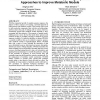6719 search results - page 140 / 1344 » A Generalization of Automatic Sequences |
CLADE
2008
IEEE
14 years 3 months ago
2008
IEEE
With the exponential growth of complete genome sequences, the analysis of these sequences is becoming a powerful approach to build genome-scale metabolic models. These models can ...
BMCBI
2007
13 years 9 months ago
2007
Background: Genome-wide association studies of common diseases for common, low penetrance causal variants are underway. A proportion of these will alter protein sequences, the mos...
PAMI
2006
13 years 9 months ago
2006
We describe a learning based method for recovering 3D human body pose from single images and monocular image sequences. Our approach requires neither an explicit body model nor pri...
ANLP
1997
13 years 10 months ago
1997
We investigate the utility of an algorithm for translation lexicon acquisition (SABLE), used previously on a very large corpus to acquire general translation lexicons, when that a...
AAAI
2004
13 years 10 months ago
2004
Learning reusable sequences can support the development of expertise in many domains, either by improving decisionmaking quality or decreasing execution speed. This paper introduc...

